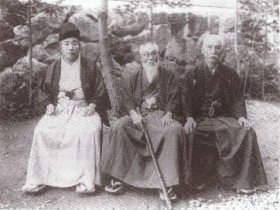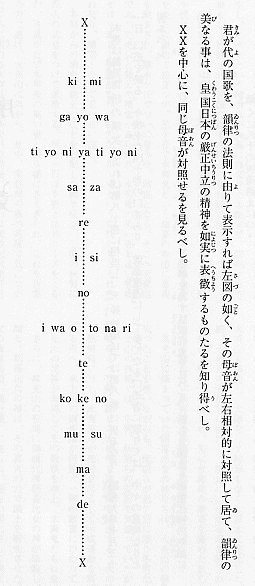

(Left to right) Onisaburo, together with leading right-wing nationalists, Mitsuru Toyama and Ryohei Uchida |
1. When was Kimigayo established as the national anthem?
(Excerpts: Talking about Japan Q&A by Kodansha International. Kodansha, 1996.)
In Meiji 26 (1893), the Ministry of Education decreed that Kimigayo would be incorporated into primary education as the anthem to be sung at ceremonies honoring national holidays.
Actually, the person who stressed the need for establishing a Japanese national anthem was a British military band leader named Fenton; the words for the song came from a poem in the Kokinwakashu and the Wakanroeishu.
After much deliberation over the selection of a melody,
a melody by the gagaku (ancient court music) composer Hayashi Hiromori was adopted in 1880, and then arranged by the German music educator Franz Eckert to constitute today's Kimigayo.
However, during the adverse course of history that followed, which saw the Sino-Japanese War, the Russo-Japanese War, the Manchurian Incident and the Pacific War, the national anthem took on militarist overtones, which exposed it to a wave of criticism in the postwar period. An increasing number of people came to dismiss Kimigayo as a symbol of militarism and the emperor system.
Strangely enough, while Kimigayo is sung at the de facto national anthem, it was never legally decreed as such.
2. What do the words to Kimigayo mean?
(Excerpts: Talking about Japan Q&A by Kodansha International. Kodansha, 1996.)
These are the lyrics to Kimigayo:
[Japanese]
kimi ga yo wa
tiyo ni yatiyo ni
sazare ishi no
iwao to nari te
koke no musu made
|
[English]
The thousands of years of happy reign be thine;
Rule on, my Lord, till what are pebbles now
By age united to mighty rocks shall grow
Whose venerable sides the moth doth line.
(Translated by Basil Hall Chamberlain)
|
Kimi can mean "lord, household, head, friend, lover." In modern Japanese kimi is used to address a new companion or a subordinate. But during the militarist period, kimi also was directly associated with the Emperor.
The overall meaning of the words, simply stated, is somewhat similar to "To your good health! And long life!" The problem then would probably lie in the fact that the lyrics are antiquated, and the melody too slow for young people accustomed to eight-beat melodies. There are those pushing for the adoption of a new national anthem.
3. Onisaburo's Interpretation of Kimigayo from the Perspective of Kototama
Onisaburo is probably the first person to dissect the Japanese Anthem of Kimigayo with the scalpel of kototama (a belief that a sacred power or spirit dwells in the words of the traditional Japanese language). He maintains that all things are created with kototama - the very assertion that would remind the reader of St. John's Gospel:
In the beginning was the Word, and the Word was with God, and the Word was God.
The same was in the beginning with God.
All things were made by him; and without him was not any thing made that was made (1: 1-3).
As explained above, during the militarist period, kimi was directly associated with the Emperor. Onisaburo, however, argues otherwise:
Ki and mi as in kimi represent Izana-gi (or -ki )-no-mikoto ("His Augustness the Male-Who-Invites") and Izana-mi-no-mikoto ("Her Augustness the Female-Who-Invites"), respectively, thus signifying the "Creator" altogether.
For reference, see SECT. II. - THE SEVEN DIVINE GENERATIONS of the Kojiki ("Records of Ancient Matters") by Basil Hall Chamberlain.
In Vol. 80 (dictated July 26 - July 31, Showa 9 [1934]) of the Reikai Monogatari, Onisaburo touches on Kimigayo as follows:
The left diagram shows a schematic arrangement of vowels in the national anthem of Kimigayo. These vowels are symmetrical along the X - X' line, with their prosodic beauty bearing eloquent witness to the spirit of strict neutrality upheld by Japan under divine protection.

Kimigayo in light of kototama (Vol. 80) |
|
|
|
|
X |
|
|
|
|
|
|

|
|
|
|
|
|
|
 |
|
|
|
|
|
|
 |
|
|
|
|
|
ki |
 |
mi |
|
|
|
|
|
 |
|
|
|
|
|
ga |
yo |
wa |
|
|
|
|
|
 |
|
|
|
| ti |
yo |
ni |
ya |
ti |
yo |
ni |
|
|
|
 |
|
|
|
|
|
sa |
 |
za |
|
|
|
|
|
 |
|
|
|
|
|
|
re |
|
|
|
|
|
|
 |
|
|
|
|
|
i |
 |
shi |
|
|
|
|
|
 |
|
|
|
|
|
|
no |
|
|
|
|
|
|
 |
|
|
|
| i |
wa |
o |
 |
to |
na |
ri |
|
|
|
 |
|
|
|
|
|
|
te |
|
|
|
|
|
|
 |
|
|
|
|
|
ko |
ke |
no |
|
|
|
|
|
 |
|
|
|
|
|
mu |
 |
su |
|
|
|
|
|
 |
|
|
|
|
|
|
ma |
|
|
|
|
|
|
 |
|
|
|
|
|
|
de |
|
|
|
|
|
|
 |
|
|
|
|
|
|
 |
|
|
|
|
|
|
 |
|
|
|
|
|
|
X' |
|
|
|
|
At least from the perspective of kototama, Japan has what it takes to act as a "mediator of the world."
|
